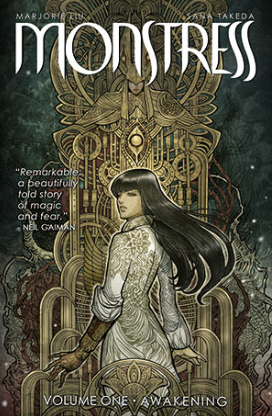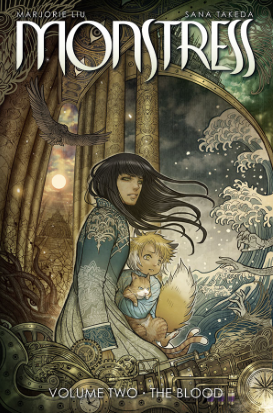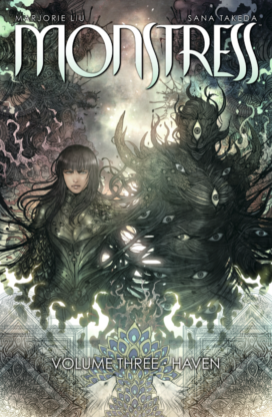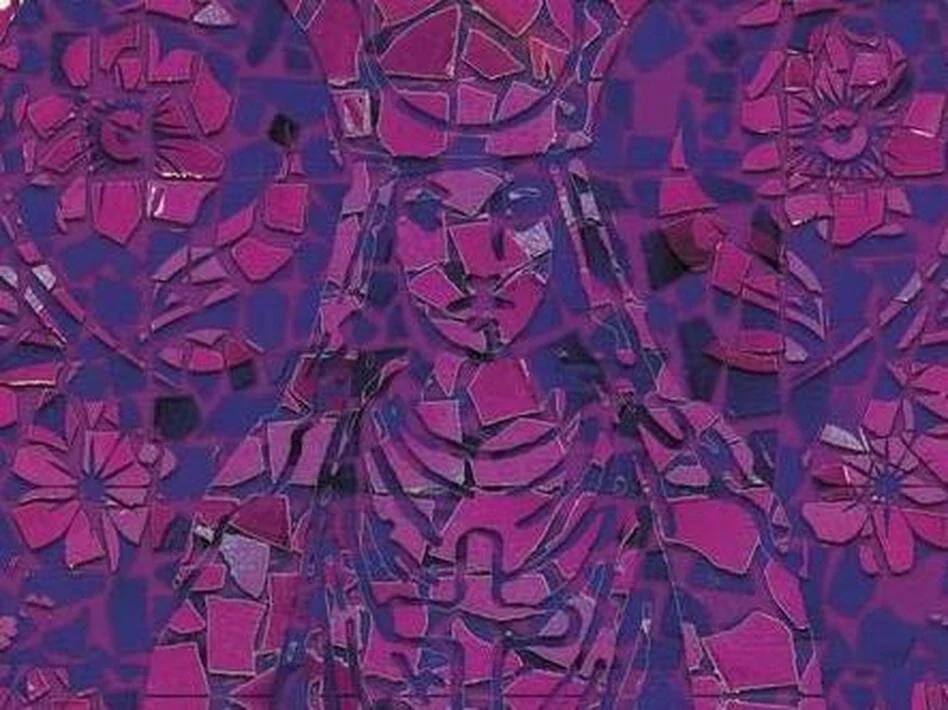Lisa Mahoney Recommends: Monstress, written by Marjorie Liu and illustrated by Sana Takeda
Recommended by a “best of” list at NPR, Monstress is a collection of comics split into three parts at natural breaks in the story. The highly-anticipated third volume published on September 5. The lush artwork and exotic deities have more in common with manga and Eastern traditions than classic American comic books and religions, which is fitting since the book’s setting resembles an alternative, steampunk Asia around 1900.
Issues 1 through 6 (Act I, if you will) introduce us to our heroine, Maika Halfwolf, who is out for vengeance against the Federation, a kingdom of humans which fought a terrifying war against her people, arcanics, whom they enslave. She’s also after the human witches who feed on a magical power of arcanics. As Maika, who can pass as human, allows herself to be enslaved to gain proximity to her witch target, writer Marjorie Liu begins to reveal the complex and violent history of this matriarchal world and its gods, ancients, arcanics, humans, and mixed breeds. Because Maika looks human but is a powerful arcanic, she fits in neither place, and that’s before a powerful ancient god begins to manifest inside her mind and outside through her half-arm. The creature has slept a long time, surfaces hungry, and rips right into nearby innocents. Maika struggles to restrain it, often failing, but as it begins to analyze her memories and its current situation, it occasionally finds common cause with her, and then they are unstoppable.
As Maika progresses on her heroic journey of self-discovery, she wins an ancient object of dark power, collects—despite herself—the devotion of a sweet sidekick with a conscience, and searches for clues about why her mother, a daughter of one of the most powerful ancient gods, decided to have Maika. Turns out it was for a purpose other than for love. Maika seems to be backstabbed and used as a pawn by everyone, but fights everything and, in the longstanding tradition of misunderstood comic superheroes with the world against them, always gets up again no matter how battered she is. Unlike some superheroes, Maika has no pointless ethics; she’ll lie and break her word if the entity she’s dealing with is evil. She is a superhero role model much admired by today’s independent young women.
The first book starts violently, with gore, blood, and death at every turn, a turnoff that made me fear the series would be like comics written by and for men but substituting in women characters. However, as the issues progress, the pace slows and the story delves more deeply into Maika’s painful memories of her childhood with her mother and develops her relationship with her seafaring father who is still alive. We also learn about plots within plots, including deceptive friends. Maika can’t trust anyone, especially the monster inside her.
Wherever she goes, Maika doesn’t fit in. Similarly, writer Marjorie Liu, who is half white, half Chinese, once felt rejected by her fellow students of Chinese descent, and it seems logical that she wrote X-Men comics before developing Monstress. In Maika’s world, you can be enslaved and your life forces can devoured by witches if you are not a pure-blooded human. In Monstress, we see a world devoured by racial hatred and wars of conquest, a grim model we should all fear and actively seek to avert in our own world.
MONSTRESS VOL 1 won the Hugo and the British Fantasy Award for Best Graphic Novel in 2017. MONSTRESS VOL 1 and VOL 2 have collectively been nominated for 9 Eisner Awards. Sana Takeda won the 2018 National Cartoonist Society Award for Best Graphic Novel for Monstress Vol 2: The Blood.
Sean Cassity Recommends: Black Hole, written and illustrated by Charles Burns
Everyone knows the Bug is out there. And they know the only way to get it is having sex with another infected person. Anyone with the Bug becomes increasingly deformed and is an instant outcast, but the teenagers in Charles Burn’s Black Hole just can’t stop reaching out to each other, eager for that most intimate of connections despite the obvious risks. That’s one of the most frightening things in the many horrors of Black Hole—how slavishly we obey our drives and the stupid things we will do to satisfy them.
Horror has a long, contentious relationship with sex, from the vampire’s sensual kiss to the slasher’s license to kill the unwed intercourser. The stalking curse in the unforgettable It Follows is tearing through a chain of love-makers until it can find, apparently, the oldest living relative of the original Adam. But Black Hole isn’t concerned with anything as simple as the wages of sin. Adolescence itself is the horror. Sex just makes it more horrifying. And the Bug makes the horror apparent to everyone. It’s a scarlet letter you can’t tear off your bodice, unless you tear off much of your body with it.
It’s worth noting that the Bug doesn’t kill you. It doesn’t degrade your brain. It doesn’t cause any pain. It just makes you outwardly deformed in some way. It’s a skin condition, really. For some the condition is minor enough that they can hide it and “pass” as normal. For these people, life continues almost as normal. Because the real impact of the Bug isn’t what it does to you itself, it’s how it changes the way others treat you. It makes you different—and there is no greater crime in this adolescent universe than being different.
Black Hole is graphic novel worth coming back to time and time again. It’s far more interested in its people than its premise. It allows its protagonists to be sympathetic and cruel, thoughtful and capricious. The world is as complicated as its characters and never lets you settle into one simple interpretation. It’s a book that forces you to reflect on it and it never really lets you go.
Lisa Mahoney Still Recommends: The Sandman by Neil Gaiman but Read Sandman Universe #1 overseen by Neil Gaiman as a Taste of Things to Come
Things are not right in the realm of dreams and nightmares. The library of the Dreaming contains all the books never written but one has gone missing, and a jagged rip slices through the realm, sky to land. Daniel, Lord of Dreams, one of the Endless, is missing, away on “a private matter,” but his minions determine they need to disturb him and get his help. They send out the raven Matthew to find Lord Daniel, but as ravens often are, he is attracted to odd things, to strange turnings, to things that just aren’t normal. The raven blunders across the Dreaming and meets a girl with anger issues who has the power to manipulate others’ dreams—something she should not be able to do. Leaving her to continue his search for the Lord of Dreams, Matthew passes through London where a schoolboy may be learning to read the missing book of magic, and encounters Lucifer about to embark upon a journey involving a son he can be no father to. In New Orleans, a Caribbean goddess of women tells their stories, which, she warns, never have happy endings. And so, we are introduced to the goddess Erzulie, who will star in her own spinoff comic book series set to begin shortly. Meanwhile, Daniel the Endless, Lord of Dreams, does not want to be found. In fact, what if he quits?
The Sandman series, written by Gaiman from 1989 through 1996, remains one of the finest graphic novels ever published, and one of Gaiman’s best efforts, in any medium. Simply put, the series’s creativity and depth made Gaiman a cultural icon and its various artists famous. Sandman Universe, without much of a storyline, serves as an introduction to the four independent spinoffs that will begin publishing this fall. They will be overseen by Gaiman but written by others. Will any be as good as The Sandman? We are anxious to find out.
The Lord of Dreams let down the teenager Dora, who seems to defy all the rules of the Dreaming ... and has anger issues.













Cadwell Turnbull's new novel — the first in a trilogy — imagines the hard, uncertain work of a fantastical justice.